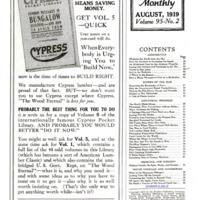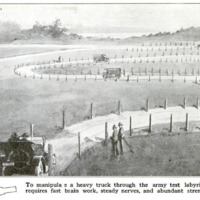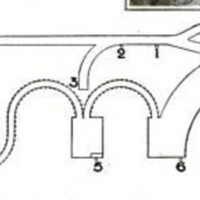The test made by the U. S. Government to choose the truck-drivers, who were sent to Europe during World War I
Item
-
Title (Dublin Core)
-
The test made by the U. S. Government to choose the truck-drivers, who were sent to Europe during World War I
-
Article Title and/or Image Caption (Dublin Core)
-
How the Government Rated Its War Truck-Drivers
-
extracted text (Extract Text)
-
WITH the need for 92,550 truck-
drivers for overseas duty soon
after our entrance into the war, the
Government decided to evolve some
simple plan for rating each driver ap-
plicant. The test was divided into two
parts—one an oral test and the other
an actual driving test over the irregu-
lar-shaped course shown herewith.
Starting from the beginning of the
test course is a straightaway to which
the applicant must drive the truck.
He takes it to post 1 with a scorer on
the seat beside him. Then he runs
down the road, turns off to the left on
the curve to post 2, and runs to post 3,
from which he must back up to the
straightaway.
This gives the scorer opportunity to
determine whether the applicant is
sufficiently advanced to proceed with
the balance of the test. If heis, he must
then drive around the far end of the
course and enter the
S-shaped road, which
is lined off on each
side with stakes about
four feet high and
five feet apart. The
road is very narrow,
so that the driver must know how to
steer so as to pass between the stakes
without knocking any of them down.
Coming out of the S curve, the
driver must run his truck up front-
ways to the center of a board set up on
stakes at post 5. Leaving that post,
he must then back his vehicle around
the semi-circular narrow road and to a
second board supposed to represent a
loading platform. The semi-circular
road is also lined with
stakes, which the driver
must not knock down.
From post 6 the driver must run up-
hill to the starting-point, stopping the
truck on the hill and backing down to
turn completely around, and he must
do this without stalling the engine or
grinding the gears.
The driver's skill between the con-
secutive posts is scored by means of
points. There are twenty-four points
in all. If the driver performs per-
fectly between each two posts, he is
given one or two points. If he fails,
he is given a 0 point for that particular
part of the test. For making three or
fewer failures a man is rated as an
expert; for four to nine, a journey-
man; for ten to fifteen failures, an
apprentice; and for sixteen or more
failures, a novice.
The total length of the course is
1,100 feet, of which 600 feet is the hill
and staked-off portion. The Govern-
ment officials in charge of the test
consider that it was ninety per cent
perfect, judging by results.
-
Language (Dublin Core)
-
eng
-
Date Issued (Dublin Core)
-
1919-08
-
pages (Bibliographic Ontology)
-
29
-
Rights (Dublin Core)
-
Public domain (Google digitized)
-
Archived by (Dublin Core)
-
Davide Donà
-
Alberto Bordignon (Supervisor)
 Popular Science Monthly, v. 95, n. 2, 1919
Popular Science Monthly, v. 95, n. 2, 1919




